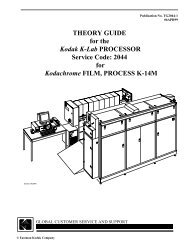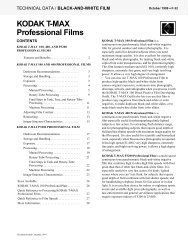Studio 125 - 125px
Studio 125 - 125px
Studio 125 - 125px
Create successful ePaper yourself
Turn your PDF publications into a flip-book with our unique Google optimized e-Paper software.
Film Data Sheet<br />
<strong>Studio</strong> <strong>125</strong><br />
Instant Pack Film (not sold in U.S.A.)<br />
Film Speed<br />
ISO <strong>125</strong>/DIN 22<br />
Format<br />
3 1 /4 x 4 1 /4 in. (8.5 x 10.8 cm)<br />
Pack Film<br />
Image Area<br />
2 7 /8 x 3 3 /4 in. (7.3 x 9.5 cm)<br />
Finish<br />
Glossy or silk<br />
Color Instant Pack Film<br />
3 1/4 x 4 1/4 inch<br />
8.5 x 10.8 cm.<br />
Exposures per Unit<br />
10 exposures per pack<br />
2 packs per box<br />
Development Time<br />
90 seconds at<br />
70°-95°F (21°-35°C)<br />
film<br />
<strong>Studio</strong><br />
<strong>125</strong><br />
Description<br />
Medium-speed, medium-contrast, medium-grain, daylight and<br />
electronic flash balanced (5500°K) color print film. This film<br />
features accurate colors and bright whites; sharp, vibrant,<br />
saturated proofs and final art; lower contrast for greater detail<br />
when compared to Polaroid Pro 100 film; improved reciprocity<br />
characteristics, and fast clearing and drying.<br />
Key Application<br />
• Passport/document photography<br />
Compatible Hardware<br />
• Any instrument or camera equipped with a CB-103 Back, OEM<br />
CB-100 Back, or Model 405 Film Holder.<br />
Special Instructions<br />
Temperature affects the final image:<br />
Processing at temperatures above 95°F (35°C) or below 55°F<br />
(13°C) is NOT recommended. Best results obtained between<br />
70°-85°F (21°-29°C).<br />
Force-drying prints:<br />
Allow the print to air-dry for at least thirty (30) seconds before<br />
using a forced-hot-air dryer.<br />
Viewing:<br />
When evaluating the color balance of a print, use the same light<br />
source under which the print is to be viewed as a finished product.<br />
Laminating prints:<br />
This film is NOT recommended for use with laminates requiring a<br />
wet print to produce a photo-destruct bond. Use T-669 or<br />
Polacolor 100 film for lamination applications.<br />
Processing Information<br />
Temperature Proc. Equivalent Exposure<br />
°F °C Time Film Speed Adjustment<br />
(sec.) (ISO/DIN)<br />
70-95 21-35 90 <strong>125</strong>/22 None<br />
65-69 18-20 120 <strong>125</strong>/22 None<br />
61-64 16-17 150 <strong>125</strong>/22 None<br />
55-60 13-15 180 <strong>125</strong>/22 None<br />
Caution<br />
This film uses a small amount of caustic paste. If any paste appears, avoid contact with skin, eyes and mouth<br />
and keep away from children and animals. If you get some paste on your skin, wipe it off immediately, then<br />
wash with water to avoid an alkali burn. If eye contact occurs, quickly wash the area with plenty of water and<br />
see a doctor. Keep discarded materials away from children, animals, clothing and furniture.<br />
Limited Warranty<br />
See information on the film box.<br />
“Polaroid” and “Polacolor” are trademarks of Polaroid Corporation, Waltham, MA 02451 USA.
Film Data Sheet<br />
Technical Data<br />
<strong>Studio</strong> <strong>125</strong><br />
Instant Pack Film (not sold in U.S.A.)<br />
The information in this data sheet<br />
represents the typical performance<br />
of <strong>Studio</strong> Polaroid instant pack film.<br />
Specific film lots may vary.<br />
Recommended speed:<br />
ISO/DIN <strong>125</strong>/22 O<br />
Recommended processing<br />
time and temperature:<br />
90 seconds at 70 O -95 O F<br />
(21 O -35 O C)<br />
Balance:<br />
Daylight and electronic<br />
flash (5500 O K)<br />
Contrast:<br />
Medium<br />
D-Max: The density value for the<br />
film’s darkest black.<br />
D-Min: The lowest density value that<br />
a film exhibits. In prints, the<br />
whiteness of the brightest highlight,<br />
relative to the unprocessed print.<br />
Slope: The positive ratio of the log E<br />
increments of the straight line region<br />
of the curve, as determined by the<br />
1/4-3/4 increment method. The slope<br />
of an H&D curve indicates the overall<br />
contrast of a film: low contrast<br />
slopes less than 1.10; medium<br />
contrast slopes from 1.10 to 1.70;<br />
high contrast slopes greater than<br />
1.70.<br />
Sample Density<br />
Sample Density<br />
2.5<br />
2<br />
1<br />
2.5<br />
2<br />
1<br />
0<br />
Characteristic H & D curves for<br />
normal development<br />
H & D Curves<br />
@ 71 O F/21 O C<br />
-3 -2 -1 0<br />
Characteristic H & D curves for<br />
cold development<br />
H & D curves<br />
@ 55 O F/13 O C Blue<br />
Green<br />
Red<br />
0<br />
-3 -2 -1 0<br />
Relative Log Exposure<br />
Relative Log Exposure<br />
Sample Density<br />
2.5<br />
2<br />
1<br />
Blue<br />
Green<br />
Red<br />
DMAX DMIN SLOPE<br />
Red 2.00 .11 1.48<br />
Green 2.06 .11 1.43<br />
Blue 1.59 .08 1.32<br />
Characteristic H & D curves for<br />
hot development<br />
H & D curves<br />
@ 95 O F/35 O C<br />
Blue<br />
Green<br />
Red<br />
-3 -2 -1 0<br />
Relative Log Exposure
Film Data Sheet<br />
Technical Data<br />
<strong>Studio</strong> <strong>125</strong><br />
Instant Pack Film (not sold in U.S.A.)<br />
Spectral Sensitivity<br />
Log Relative Sensitivity<br />
40<br />
35<br />
30<br />
25<br />
20<br />
15<br />
10<br />
Spectral Sensitivity<br />
5<br />
0<br />
350 400 450 500 550 600 650<br />
1.5<br />
1.0<br />
0.5<br />
0.0<br />
-0.5<br />
Wavelength (nm)<br />
Action Sensitivity<br />
Blue<br />
Green<br />
Red<br />
-1.0<br />
350 400 450 500 550 600 650<br />
Wavelength<br />
Blue<br />
Green<br />
Red<br />
Relative Log Exposure<br />
2.0<br />
1.6<br />
1.2<br />
0.8<br />
0.4<br />
Reciprocity Law Failure<br />
Blue<br />
Green<br />
Red<br />
0.0<br />
0.01 0.1 1 10 100<br />
Exposure Time (seconds)<br />
Reciprocity: The ability of the film to respond in a constant<br />
manner to a constant exposure (light intensity x time ). Reciprocity<br />
failure occurs during very long or very short exposures, requiring<br />
the photographer to increase exposure.<br />
Spectral Sensitivity: Shows the equivalent energy needed at each<br />
wavelength in order to activate the emulsion dyes so that they<br />
produce a neutral density of 0.75.<br />
Action Spectra: Shows the film’s relative sensitivity throughout the<br />
visual spectrum.
Film Data Sheet<br />
Technical Data<br />
<strong>Studio</strong> <strong>125</strong><br />
Instant Pack Film (not sold in U.S.A.)<br />
Intermittency Effect (Multi-Pop)<br />
Polaroid Proof (P6) Ektachrome (100Plus)<br />
# of Flashes Exposure<br />
Change*<br />
Color Correction** Exposure<br />
Change*<br />
1 none none none none<br />
2 1 stop cc 5 red 1 stop none<br />
4 1 2/3 stops<br />
cc 5 red<br />
1 2/3 stops none<br />
8 2 1/2 stops cc 5 magenta<br />
+ 5 cc red<br />
16 3 1/3 stops cc 10 magenta<br />
+ 10 cc red<br />
Color<br />
Correction**<br />
2 1/2 stops cc 5<br />
magenta<br />
3 stops cc 5<br />
magenta<br />
* Decrease (close down) the aperture by this amount with indicated filtration to<br />
obtain correct exposure with constant intensity of illumination per “pop”.<br />
** The Polaroid Proof has an increasing green color from 4 to 16 flashes.<br />
Use the above magenta filtration to subtract green.<br />
Use these recommendations as a starting point and guide to obtain the optimum<br />
exposure and color balance.
















